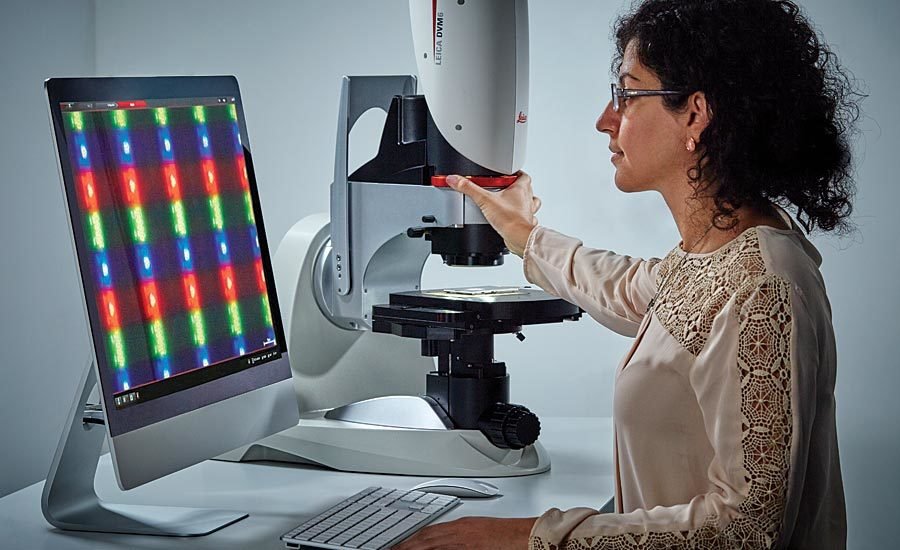In today’s technologically driven world, the ability to observe and analyze objects at a microscopic level has been revolutionized by the advent of professional digital microscopes. These devices, which merge traditional microscopy with digital technology, offer unparalleled precision and functionality in various scientific, industrial, and educational settings. But what exactly are professional digital microscopes, and why are they becoming indispensable tools in many fields? Let’s delve into the world of digital microscopy to uncover their significance and potential.
Key Features of Professional Digital Microscopes
Professional digital microscopes stand out due to their advanced features that cater to the needs of modern professionals. One of the most notable features is high-resolution imaging. Unlike traditional microscopes, which rely on the user’s eyesight to observe details through eyepieces, digital microscopes convert optical images into digital signals. These images can be displayed on monitors with stunning clarity, allowing for precise analysis and documentation.
Another critical feature is the digital display and connectivity options. These microscopes can connect to computers, tablets, or even smartphones, enabling users to capture images, record videos, and share their findings instantly. This connectivity is especially useful in collaborative environments where multiple users need to view the same specimen simultaneously.
Advanced software integration also plays a significant role. The software that accompanies digital microscopes often includes tools for measurement, annotation, and image enhancement, streamlining the workflow for researchers and engineers. Additionally, the magnification capabilities of digital microscopes are impressive, with some models offering zoom levels that reveal details invisible to the naked eye.
Lastly, the portability and ergonomics of digital microscopes make them convenient for various settings. Many models are lightweight and easy to transport, allowing professionals to conduct on-site inspections or research without being tethered to a lab bench.
Types of Professional Digital Microscopes
Professional digital microscopes come in several types, each suited for specific tasks.
Handheld digital microscopes are compact and portable, making them ideal for fieldwork or situations where mobility is crucial. These microscopes are often used in industries like electronics for quick inspections or in educational settings for hands-on learning experiences.
Desktop digital microscopes, on the other hand, are more robust and offer higher magnification levels and stability, making them suitable for detailed laboratory work. These are commonly found in research institutions and quality control labs where precision is paramount.
For applications requiring depth perception, 3D digital microscopes provide three-dimensional views of specimens. This feature is particularly useful in industries like material science, where understanding the structure and texture of a sample is essential.
Applications of Professional Digital Microscopes
The versatility of professional digital microscopes is evident in their wide range of applications.
In biological research, these microscopes are invaluable for examining cells, tissues, and microorganisms. They allow scientists to observe biological processes in real-time, contributing to advances in medical research and drug development.
In industrial inspection, digital microscopes are used for quality control and failure analysis. For instance, in the electronics industry, they help identify defects in microchips or circuit boards that could compromise the performance of a device.
The educational sector also benefits significantly from digital microscopes. By integrating these tools into classrooms and laboratories, educators can provide students with interactive and engaging learning experiences. Forensic analysis is another field where digital microscopes shine, aiding in the examination of evidence such as fibers, hair, and residues that are crucial in solving crimes.
Advantages of Using Professional Digital Microscopes
One of the primary advantages of digital microscopes is enhanced precision and accuracy. The ability to capture high-definition images and videos allows for meticulous examination of samples, reducing the chances of human error.
Improved documentation and sharing capabilities are also significant benefits. Digital microscopes simplify the process of recording observations, making it easier to create detailed reports and share findings with colleagues or clients. This is particularly important in collaborative projects where consistent and accurate communication is key.
Additionally, digital microscopes offer real-time analysis and reporting. This feature is particularly useful in dynamic environments like production lines, where quick decision-making is essential. The cost-effectiveness and efficiency of digital microscopes further enhance their appeal, as they often require less maintenance and offer more functionality than traditional microscopes.
Factors to Consider When Choosing a Professional Digital Microscope
When selecting a digital microscope, it’s essential to consider the purpose of use. Different applications require different features, so it’s crucial to choose a microscope that meets your specific needs.
Resolution and magnification are also critical factors. Higher resolution and magnification levels allow for more detailed observations, but they may not be necessary for all applications. It’s important to balance these features with the requirements of your work.
Software and compatibility are also worth considering. The software that comes with the microscope should be user-friendly and compatible with your existing systems. Additionally, consider your budget and brand reputation. Established brands often offer better customer support and more reliable products.
Top Brands and Models of Professional Digital Microscopes
Several brands dominate the professional digital microscope market, each offering models with unique features.
Leica Microsystems is known for its high-quality optics and robust build quality. Their digital microscopes are widely used in research institutions and industries where precision is paramount.
Olympus Corporation offers a range of digital microscopes designed for various applications, from biological research to industrial inspection. Their models are known for their advanced imaging capabilities and user-friendly software.
Zeiss is another leading brand, particularly noted for its innovative 3D digital microscopes. These are ideal for applications that require depth perception, such as material science and forensic analysis.
Keyence offers digital microscopes that excel in industrial settings, with models designed for fast, efficient inspections and high-resolution imaging.
How to Properly Use and Maintain a Professional Digital Microscope
To get the most out of a digital microscope, it’s essential to follow basic operating procedures. Always start by calibrating the microscope according to the manufacturer’s instructions to ensure accurate measurements and observations.
Maintenance is key to longevity. Regularly clean the lenses with a soft, lint-free cloth, and avoid using harsh chemicals that could damage the optics. Additionally, keep the software updated to benefit from the latest features and improvements.
If you encounter issues, there are common troubleshooting steps to follow. These include checking the connections, ensuring that the software is correctly installed, and verifying that the microscope is receiving adequate power.
Case Studies: Professional Digital Microscopes in Action
Professional digital microscopes have been instrumental in numerous breakthroughs across various fields.
In biomedical research, digital microscopes have enabled the discovery of new cellular mechanisms, advancing our understanding of diseases and leading to the development of innovative treatments.
In manufacturing quality control, companies have used digital microscopes to enhance the accuracy of their inspections, leading to higher product quality and reduced waste. For example, in the automotive industry, digital microscopes help ensure that parts meet stringent safety standards.
In forensic investigations, digital microscopes have played a crucial role in solving crimes. By examining trace evidence such as fibers or residues, forensic scientists can uncover details that might be missed with traditional methods, providing critical leads in criminal cases.
Future Trends in Digital Microscopy
The future of digital microscopy is bright, with several exciting trends on the horizon.
Advancements in AI and machine learning are expected to revolutionize the field by automating image analysis and improving the accuracy of diagnoses in medical research. These technologies will enable microscopes to identify patterns and anomalies that may be imperceptible to the human eye.
Another trend is the increasing portability and user-friendliness of digital microscopes. As technology advances, we can expect to see more compact and intuitive models that cater to professionals who need to conduct analyses in the field.
Digital microscopes are also expanding into new fields and applications, such as environmental monitoring and space exploration. These developments will open up new possibilities for research and discovery.
Common Misconceptions about Professional Digital Microscopes
Despite their many advantages, digital microscopes are sometimes misunderstood.
One common misconception is that they are too complex to use. While it’s true that digital microscopes come with a range of features, most models are designed to be user-friendly, with intuitive interfaces and comprehensive guides that make them accessible even to beginners.
Another myth is that digital microscopes are prohibitively expensive. While high-end models can be costly, there are many affordable options available that still offer excellent performance and features. Moreover, the long-term benefits and versatility of digital microscopes often justify the initial investment.
Comparing Professional Digital Microscopes with Traditional Microscopes
When comparing digital microscopes to traditional optical microscopes, several differences stand out.
In terms of imaging quality, digital microscopes often provide superior clarity, especially when capturing and analyzing images. The ability to view samples on a large screen also reduces eye strain and allows for more detailed observations.
Ease of use is another area where digital microscopes have an edge. The ability to connect to computers and other devices simplifies data sharing and collaboration. Additionally, digital microscopes often require less manual adjustment, making them more accessible to users of varying skill levels.
Finally, when considering cost and maintenance, digital microscopes can be more cost-effective in the long run. They typically require less upkeep than traditional microscopes, and the ability to store and share digital images reduces the need for physical storage and documentation.
The Role of Professional Digital Microscopes in Remote Learning and Telemedicine
In recent years, professional digital microscopes have played a pivotal role in remote learning and telemedicine.
In educational settings, digital microscopes enable students to participate in interactive lessons from anywhere in the world. Teachers can share live images of specimens during virtual classes, providing a hands-on learning experience that rivals in-person labs.
In telemedicine, digital microscopes are used to enhance remote diagnostics. Healthcare professionals can analyze samples in real-time and share their findings with specialists in different locations, improving patient care and outcomes.
Conclusion
Professional digital microscopes represent a significant leap forward in the world of microscopy. With their advanced features, diverse applications, and growing importance in various fields, they are poised to become indispensable tools in both research and industry. As technology continues to evolve, so too will the capabilities of digital microscopes, opening up new possibilities for discovery and innovation.
FAQs about Professional Digital Microscopes
- What is the typical lifespan of a digital microscope?
- The lifespan of a digital microscope depends on the model and how well it is maintained. With proper care, a high-quality digital microscope can last for several years, often more than a decade.
- Can digital microscopes be used for live sample analysis?
- Yes, many digital microscopes are equipped with features that allow for live sample analysis, including real-time imaging and video recording.
- How do digital microscopes connect to computers or mobile devices?
- Digital microscopes typically connect via USB, HDMI, or wireless connections like Wi-Fi or Bluetooth, allowing easy integration with computers, tablets, and smartphones.
- What is the highest magnification available in digital microscopes?
- The highest magnification varies by model, but some digital microscopes can achieve magnifications of up to 10,000x or more, depending on the lens and software used.
- Are there any limitations to using digital microscopes?
- While digital microscopes offer many advantages, they may not always match the optical resolution of high-end traditional microscopes, particularly in low-light conditions. However, their versatility and ease of use often outweigh these limitations.





Leave a Reply